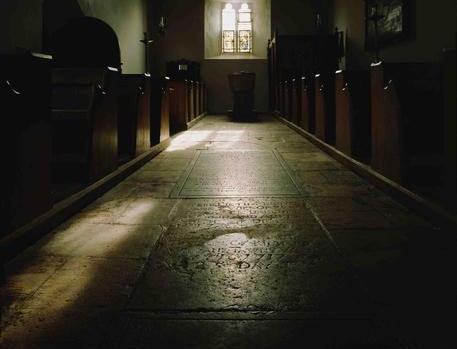
Photograph copyright ©1999 - 2018 Denis Waugh.
External Links
BINSEY
My old friend and tutor Gerda, despite having taught me all I know about writing, seems to have little faith in me.
`It's about fifteen miles,' she insists of the route to Swinford. I have worked it out painstakingly. Five miles, maximum. But I am a great believer in fence sitting.
`Hmm,' I say, agreeably, `I would have thought about ten.'
`You won't be able to cycle much of the way,' she says. `It's not a proper track. And it's very narrow.'
To which I point out that I have cycled everywhere up until now, getting off to wait for pedestrians, and I can't see the Oxford riverside meadow beating me. Anyway, I take up much less room on my bike than beside it.
`There are hundreds of books on the Thames,' she says gloomily. `I hope you've got a good angle.'
I sometimes wonder why I bother. But not for long. Gerda, bless her, takes me on a detour to the tiny hamlet of Binsey. This was the home of Miss Prickett (the Red Queen), governess to Alice Liddell, or Alice in Wonderland. The churchyard is well peopled with Pricketts, resting in such peace as is possible next door to the A34.
Binsey Church must be one of the few remaining unspoiled churches in the country. The electric age has not touched it, as the simple hanging oil lamps testify. It is part of the ancient priory of St Frideswide, a Mercian princess (died 735) who founded a nunnery in Oxford. Regardless of her decision to live a cloistered life, she was forced to flee the attentions of the persistent King Algar. Whilst Frideswide lived secretly and simply beside the Thames with a swineherd and his wife, Algar marched on Oxford with his army and the town was saved from devastation only by providence: Algar was suddenly struck blind, presumably as punishment.
The good Frideswide, though, felt sorry for Algar and prayed that his sight should be restored. In answer to her supplications a holy well sprang up (can a well spring up?) and Algar was healed by its magical water. St Frideswide built a church beside the well, which she dedicated to St Margaret of Antioch.
She probably felt some affinity with Margaret, the daughter of a pagan priest during the time of the Roman emperor Diocletian (245-313) who ordered the last great persecution of the Christians. Margaret also had to flee from the advances of an unwelcome suitor, the prefect Olybrius, who then denounced her as a Christian. She went through various tortures such as being swallowed by Satan in the guise of a dragon, and was finally beheaded.
This is the original treacle well. Remember? In Alice in Wonderland at the Mad Hatter's tea party the Dormouse (a.k.a. Charles Dodgson, a.k.a. Lewis Carroll) tells the story of the three little girls who lived at the bottom of the treacle well. In fact, this is truly a treacle well. In ancient times treacle was the term for an antidote to poison and a treacle well is thus a healing well.
When the Reverend Prout, one of Dodgson's friends, became the incumbent of St Margaret's Church and lovingly restored it (which is why it looks so perfect) he asked the author what he should do with the well. Dodgson replied that, in his opinion, his friend should `Leave well alone.' A man after my own heart. Consequently, St Margaret's well is as it should be - uncovered with mesh and unlittered with explanatory signs. Conservation at its best.
At the famous Trout Inn the barman insists that there is no local ale. I hope none of the Morrell family hear him. We sit outside with a raucous peacock for company, listening to the rushing weir and sheltered from the rain by an overhanging ivy.
`Good luck with the book,' says Gerda as we part. `I'm sure it's going to be really good.' She might have said so earlier.
Text copyright ©1999 - 2018 Priscilla Waugh.